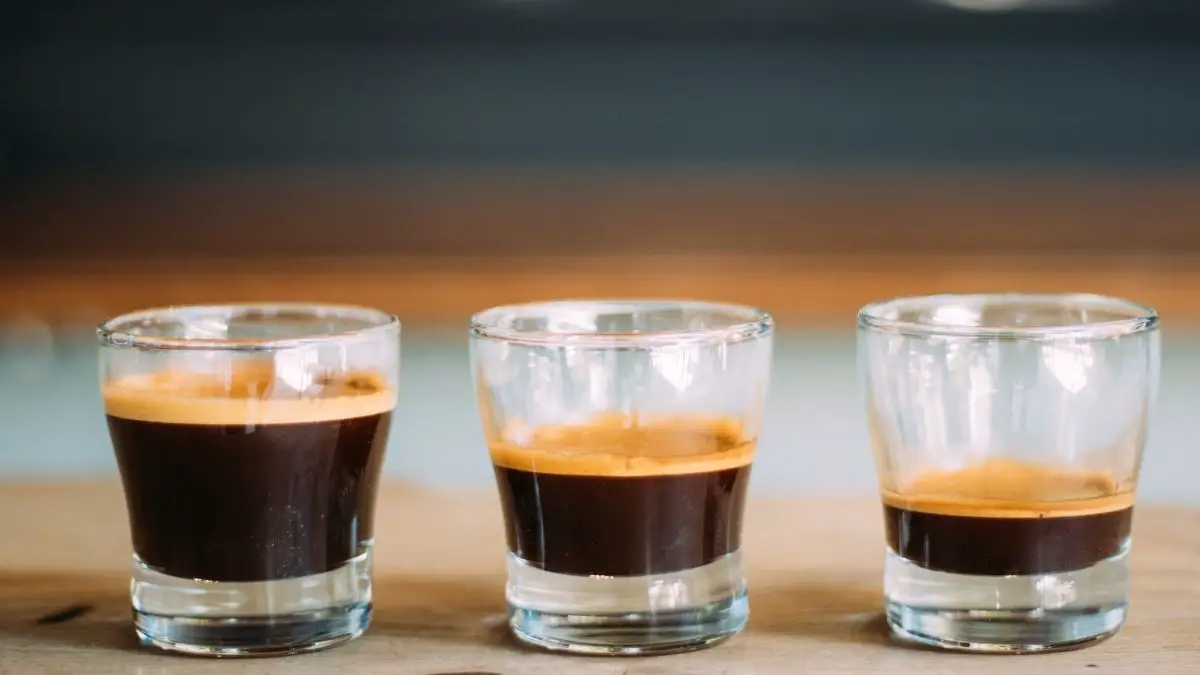Being an espresso fan, I love discussing the various types of espresso drinks and how they differ from one another in the most surprising ways. Usually, the difference between one type of espresso-based coffee and another espresso mix is just a measure of beans, water, time, and sometimes milk. However, some names may seem distinct but are just the same drink.
A short black is simply another name for the famous espresso. Usually, it refers to a single shot of espresso as in 1:2 coffee-water ratio, while a doppio refers to a double shot with the same measure.
A single shot of espresso maybe 8 to 10 grams of fine ground coffee beans extracted with 16 or 20 grams of water. An automatic espresso machine shoots highly-pressurized water through a portafilter, which then fills a preheated demitasse cup with 1.15 fl oz worth of espresso. This one ounce possesses a strong aroma and bold flavors that may intimidate a first-timer but thrill an aficionado.
Bittersweet with nutty, chocolatey, and sometimes caramelized notes, an espresso shot prides itself with a complexity of flavors in its tripartite being, stirred and swirled to a well-balanced blend. The most distinctive feature of the espresso is its thick crema, and true coffee lovers could already tell the qualities of an espresso shot by the presence of its foamy layer alone.
So then begs the question, just how many espresso drinks are out there? Well, we can already start with a short black as it’s the most basic form of espresso, but it isn’t the most commonly used base for all other espresso beverages. Instead, the standard foundation of a latte, cappuccino, and Americano is a double shot of espresso, or what we call a “doppio.”
The Basics Of Espresso
Espresso comes from the fine, powdery grounds of Arabica beans, but they’re not as minuscule as Turkish coffee grounds. Medium to medium-dark roast blends are mostly preferred for pulling a shot, and this is because these darker roast coffee types provide the balanced taste, texture, and aroma of espresso that shouldn’t incline too much toward an acidic nor rubbery, bitter mouthfeel.
Most commercial espresso grounds are blends of coffee beans from various origins. Sometimes, a bag of pure Arabica from a low-elevation country may taste more bitter and stronger than ones that are grown higher, and this drastically affects the flavor of espresso. This is why coffee beans from different countries are carefully put together to opt for a much preferable blend, one with a flexible and forgiving set of flavors.
Single-origin coffee bags are still sold out there of course, and this is best if you prefer the coffee taste from a specific region only. Blends from Brazil, Sumatra, and India are typically low-acidic with stronger earthy flavors, while Kenya and Colombia usually produce coffee with good acidity incorporated with citrus and fruity notes.
Pulling an espresso shot first comes in the form of finely ground beans, pressed with a tamper and compacted into a portafilter to ensure an evenly-distributed coffee bed and a uniform extraction degree. Next, highly-pressurized water passes through the tiny, tiny gaps, saturating the powdery grounds which now have greater surface area exposure per particle, allowing the water to extract the most flavors and caffeine into your cup in a matter of 20-30 seconds.
Different Types Of Espresso Shots
Nowadays, a shot can refer to either a single or double shot of espresso. You’d normally be served with a double shot or doppio of 36 ml; 18 g of coffee in 36 g of water. Yet, you can also order a ristretto or lungo.
Ristretto
Ristretto means restrained or to restrain in Italian, and it’s essentially a shortened espresso shot that only extracts within 15-20 seconds. Some cafes grind the beans slightly finer than the usual espresso so that there’d still be a good quality of flavors despite the shorter extraction time. What this highly-concentrated 1:1 shot will give you is a quick jab of acidity and sweeter flavors than the regular shot, as well as a heavier, thicker body due to the equal coffee-water ratio.
Lungo
Lungo means long or to prolong, and this immediately refers to lengthening the time of pulling an espresso shot, just about 40 seconds. This 1:4 espresso shot yields more coffee and also introduces the later flavors such as hazelnut and sugar caramel. It’s not as concentrated as a ristretto and a doppio, and it also has a lighter body with much less acidity, giving way to the more bitter notes. Since a lungo makes about a 72 ml coffee, it’s usually not mixed with any more water, unless asked for, and it allows you to appreciate the clearer roast profile of the blend.
Different Types Of Espresso Drinks Without Milk
Now, we can go over to the espresso-based drinks in which only water, more coffee, and some toppings are involved. Since we’re already too familiar with those that contain milk. Remember that a double shot of espresso is commonly used as the base, so you’re still going to get hints of the original flavors of espresso regardless.
Americano
A double shot of espresso is poured into hot water first, and the amount of water depends on your preferred taste. If you want it stronger, use less water, and if you want it milder, add more water.
Long Black
Similar to an Americano, but much stronger in aroma and taste due to using less water. Most popular in Australia and New Zealand, a long black has a more pronounced crema, and even when it’s produced with the same amount of water as its western brother, it’s still called a long black in its respective countries.
Red Eye
If you want to be punched awake by your coffee brew and last the entire afternoon with a bumped-up heart rate, then a red eye might be exactly what you need. Take a 12 oz drip coffee and top it with a shot of espresso. What you get is an intensely caffeinated and powerful drink that may put your love for coffee to the test.
How caffeinated is it? Well, a 12 oz drip coffee contains about 120 mg of caffeine, while a shot of espresso may contain up to 80 mg of caffeine. So let’s say you’re getting 200 mg worth of caffeine in this 14 oz beverage, or 50% of your recommended daily intake as suggested by the FDA.
Also note that without sugar or milk, this drink could be considerably bitter with but a few notes of acidity, nuts, and fruits.
Black Eye
Unsatisfied with red eye and so you think you can take a harder punch of coffee to the face? The black eye’s your next round, friend. A double shot of espresso poured over black coffee makes an extremely dark beverage that is immensely intimidating just by its aroma and looks. Not only by its appearance, but black eye packs a stronger straight punch of caffeine than the red eye, consider it to be around 250 to 400 mg of caffeine.
The intense bitter flavors of a black eye coffee are enough to literally knock a beginner to their knees, and so if you’re up to the challenge of proving yourself as a strongman coffee aficionado, consider drinking black eye straight.
Healthline warns of the side effects of ingesting too much caffeine too soon: anxiety, insomnia, digestive stress, high blood pressure, rapid heart rate, and sudden fatigue. If you want to stay on the beneficial side of caffeine, keep your intake between 200 to 400 mg. Taking more than 500 mg per day is pretty dangerous.
However, according to Sleep Education Org, half of your caffeine intake and its adverse effects dwindle within 3 to 5 hours, and the rest would eventually be digested but would have much less tangible effects. It doesn’t matter how much you took, but assuming it’s within the safe zone, it would still take about 5 hours to digest half of it.
Curious about how long does espresso last in your system? Read about it here!
Espresso Romano
You love espresso but sometimes you want a more exotic twist? Espresso Romano is a double shot of espresso topped with an ounce of fresh lemon juice. Woah, lemon juice?!
Yes, the citrus fruit flavor of lemons does make a more exciting version of espresso, and it helps counter the lingering bitterness of the drink. Add some lemon zest and what you’ll get is a desirably fragrant and aromatic drink with a balance of romantically sweet lemon and bitter cocoa tastes.
Is It Safe To Drink An Espresso Shot Straight?
Yes, in fact, most Italians do so in the morning. A short black or single shot of espresso only contains about 60 to 80 mg of caffeine depending on the coffee origins and roast, but this is but a healthy dose of caffeine that can help energize you in the morning by boosting your bodily and mental activities.
If you don’t like the strong, suddenly bitter taste of espresso, then you can always opt to add some water, milk, sugar, or syrups to tweak it to your preference.
Bottom Line
Different countries may call the same coffee under varying names, but coffee is still coffee and no matter how and where you drink it, you should covet it and indulge it the way you want to. Aficionados who prefer pure and bold coffee may like a straight espresso with an ample amount of sugar better than others who opt for a sweeter aftertaste. Coffee is wonderful as it’s very flexible and adaptable to the tastes of people who drink it.
Especially with espresso, there’s almost no end to how many espresso-based drinks are out there and continuously being invented. Gotta taste them all!


